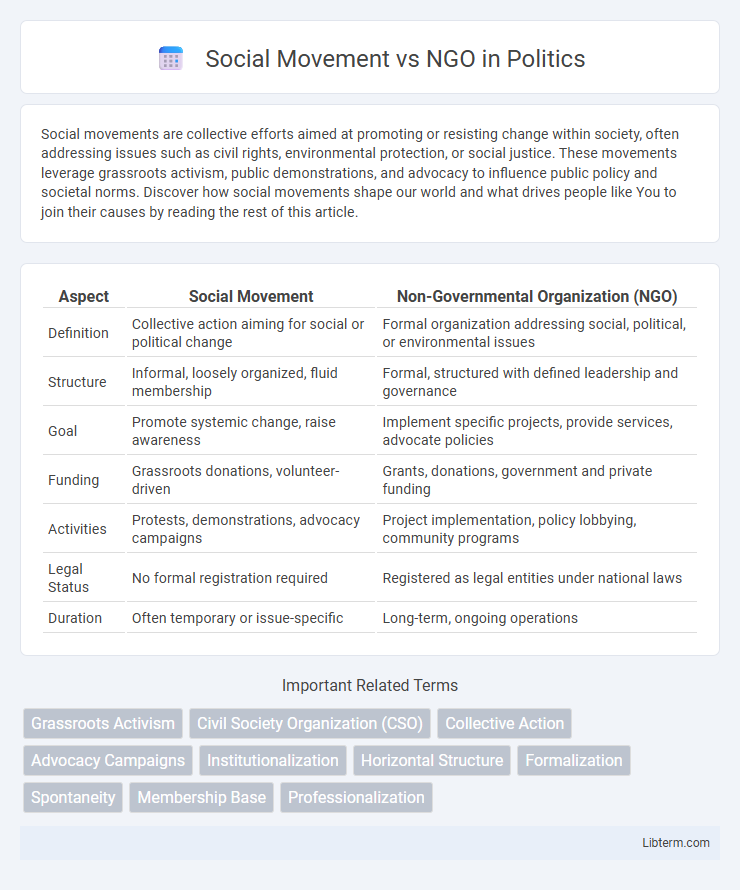Social movements are collective efforts aimed at promoting or resisting change within society, often addressing issues such as civil rights, environmental protection, or social justice. These movements leverage grassroots activism, public demonstrations, and advocacy to influence public policy and societal norms. Discover how social movements shape our world and what drives people like You to join their causes by reading the rest of this article.
Table of Comparison
| Aspect | Social Movement | Non-Governmental Organization (NGO) |
|---|---|---|
| Definition | Collective action aiming for social or political change | Formal organization addressing social, political, or environmental issues |
| Structure | Informal, loosely organized, fluid membership | Formal, structured with defined leadership and governance |
| Goal | Promote systemic change, raise awareness | Implement specific projects, provide services, advocate policies |
| Funding | Grassroots donations, volunteer-driven | Grants, donations, government and private funding |
| Activities | Protests, demonstrations, advocacy campaigns | Project implementation, policy lobbying, community programs |
| Legal Status | No formal registration required | Registered as legal entities under national laws |
| Duration | Often temporary or issue-specific | Long-term, ongoing operations |
Understanding Social Movements
Social movements are collective efforts aiming to bring about social or political change by mobilizing large groups of people around shared goals and values. Unlike NGOs, which are formal organizations with structured leadership and specific programs, social movements often emerge spontaneously and rely on grassroots participation. Understanding social movements involves analyzing their origins, strategies, and impact on public policy and societal norms.
Defining Non-Governmental Organizations (NGOs)
Non-Governmental Organizations (NGOs) are structured, nonprofit entities that operate independently from government influence to address social, environmental, or humanitarian issues through organized programs and advocacy. Unlike social movements, which are grassroots efforts driven by collective public action and spontaneous social change, NGOs maintain formal governance, funding mechanisms, and long-term strategic goals. These organizations engage in policy development, service delivery, and community mobilization within legal frameworks to create sustainable impact.
Key Characteristics of Social Movements
Social movements are collective, grassroots efforts driven by shared values and social change, characterized by widespread participation, sustained activism, and a flexible organizational structure. Unlike NGOs, social movements often emerge spontaneously and operate without formal registration or hierarchical governance. These movements leverage symbolism, public demonstrations, and mass mobilization to influence public opinion and policy on issues such as civil rights, environmental justice, and political reform.
Core Functions of NGOs
Non-governmental organizations (NGOs) primarily focus on service delivery, advocacy, and capacity building to address social issues, contrasting with social movements that aim for broad societal change through collective action. NGOs implement structured programs, provide resources, and engage in policy dialogue to achieve their objectives, emphasizing accountability and sustainability. Their core functions include humanitarian aid, development initiatives, human rights promotion, and environmental protection, operating within formal frameworks and often collaborating with governments and international bodies.
Goals and Motivations: Social Movements vs NGOs
Social movements aim to create broad societal change by mobilizing collective action around shared grievances, often driven by grassroots support and a desire for systemic transformation. NGOs typically focus on specific issues with structured programs, relying on professional management and funding to implement targeted interventions and policy advocacy. While social movements emphasize participatory activism and radical goals, NGOs prioritize sustainable development, service delivery, and institutional partnerships.
Organizational Structure and Leadership
Social movements typically feature decentralized organizational structures with fluid leadership, allowing grassroots participation and collective decision-making. NGOs often maintain formal hierarchies with defined roles, ensuring clear accountability and strategic management by appointed leaders or boards. The contrast in leadership styles reflects the social movement's emphasis on egalitarian engagement versus the NGO's need for structured governance to achieve specific goals.
Funding and Resource Mobilization
Social movements primarily rely on grassroots support, volunteer efforts, and decentralized funding sources to mobilize resources, often emphasizing collective action and local engagement. NGOs secure funding through formal channels such as grants, donations from philanthropic organizations, government contracts, and international aid, facilitating structured financial management and accountability. The scale and sustainability of resource mobilization in NGOs tend to be more predictable compared to the often spontaneous and fluctuating support found in social movements.
Strategies and Methods of Advocacy
Social movements utilize grassroots mobilization, mass protests, and viral digital campaigns to create widespread social awareness and pressure for systemic change. NGOs employ targeted lobbying, policy research, and strategic partnerships with government and international bodies to influence legislation and program implementation. Both rely on storytelling and data-driven advocacy but differ in scale and structure, with social movements focusing on broad public engagement and NGOs emphasizing organized, professionalized interventions.
Long-Term Impact and Sustainability
Social movements drive long-term societal change by mobilizing collective grassroots action that reshapes cultural norms and public policies over time. NGOs implement targeted projects and provide continuous services, ensuring sustained support and measurable community development outcomes. The combination of social movements' broad mobilization and NGOs' structured resources enhances long-term impact and sustainability in social change efforts.
Collaboration and Tensions between Social Movements and NGOs
Social movements and NGOs often collaborate to amplify social change efforts, leveraging NGOs' resources and institutional access alongside grassroots mobilization. Tensions arise due to differing organizational structures, with social movements prioritizing radical change and NGOs favoring incremental policy reforms. This dynamic creates a complex interplay where mutual goals drive cooperation, but contrasting strategies and accountability mechanisms lead to friction.
Social Movement Infographic

 libterm.com
libterm.com